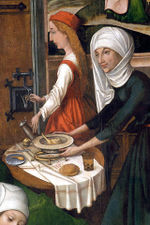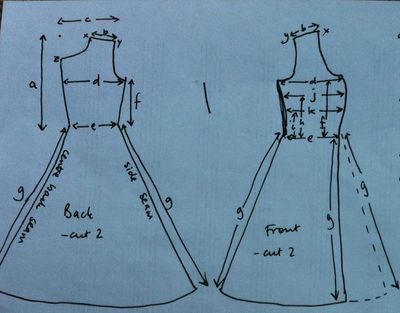How to - Make a kirtle
| Line 32: | Line 32: | ||
[[File:Kirtle4.jpg|400px|thumb|left|Back and front pattern pieces]] | [[File:Kirtle4.jpg|400px|thumb|left|Back and front pattern pieces]] | ||
These are the two pattern pieces that you're going to map out. As written you'll get a pattern for a close-fitting, supportive dress with little or no ease - if you're anxious about the fit or want a looser kirtle then add a couple of inches to the seam allowances at the sides, and pin it to check the fit and adjust before you start sewing. | |||
====Key to measurements==== | |||
a)nape of neck to waist + 1/2 an inch. Point z is 2 inches below this line. | |||
b)base of neck to shoulder - point x should be about 1 inch higher than point y so the shoulder line slopes nicely. | |||
c)1/2 inch + 1/2 of the distance between your shoulders measured behind your head | |||
d)1 inch + 1/4 of your underbust measurement | |||
e) 1 inch + 1/4 of your waist measurement | |||
====Hungry for more?==== | ====Hungry for more?==== | ||
Revision as of 14:31, 11 July 2013
How to make a Kirtle
What's a kirtle, I hear you ask? Well, it's a term used to describe a close fitting dress or underdress, worn through a lot of the middle ages. The one we're going to make today is roughly based on the ones they were wearing in the 15th century, and it's a lovely comfortable and practical garment that's cool in summer and works as a great underlayer in winter. This one is sleeveless but you could add sleeves, or make a separate pair and lace or pin them on for a different look.
If you're part of the Marcher Authenticity Brigade (of which I'm a fully paid up obsessional member) you'll be pleased to see these historical images of women wearing sleeveless kirtles just like the ones we're going to make. In late 15th century art you see women painted in domestic situations in just this kind of sleeveless kirtle, particularly in pictures about births. For everyone else, they do look cool, don't they?
You will need
- 3m of cotton, linen or lightweight wool, 60 inches wide (if you're making a particoloured dress like mine get 1.5m of each) (I used linen look cotton at £5 per metre - you could use ikea coloured cotton at £3 per metre if you wanted something cheaper - £15)
- 3m of cotton lining (Bomull from ikea is great - £1.75 per metre for unbleached calico) (£5.25)
- Thread in a matching or darker colour. (TIP: if you think you might dye the garment later, get cotton or silk thread. Normal sewing thread won't dye and you'll end up with visible stitching. Coats cotton thread is very good. Guterman quilting cotton thread is too coarse.) (£1)
- A tape measure
- A pen, soft pencil or chalk
- A packet of eyelets (£4)
- 2-3 metres of ribbon, cotton tape or cord (£1)
- An iron
Total cost - £26.25
The Basic Process
What we're going to do is draw a simple pattern consisting of two back and two fronts based on your body measurements. We'll then assemble the lining and the outer fabric step by step, with no visible machine stitching or need for hand finishing except for the bottom hem which you can choose to finish by machine or by hand depending on your preference. There are quite a few steps to the process but none of them is hard, and by taking it a bite at a time even a beginner can make a success of the project.
Making your pattern
These are the two pattern pieces that you're going to map out. As written you'll get a pattern for a close-fitting, supportive dress with little or no ease - if you're anxious about the fit or want a looser kirtle then add a couple of inches to the seam allowances at the sides, and pin it to check the fit and adjust before you start sewing.
Key to measurements
a)nape of neck to waist + 1/2 an inch. Point z is 2 inches below this line. b)base of neck to shoulder - point x should be about 1 inch higher than point y so the shoulder line slopes nicely. c)1/2 inch + 1/2 of the distance between your shoulders measured behind your head d)1 inch + 1/4 of your underbust measurement e) 1 inch + 1/4 of your waist measurement
Hungry for more?
Why not use the How to make a t-tunic tutorial to make a shift to go under it - if you get an extra 2m of ikea bomull cotton it makes a great lightweight underlayer and you're still under £30!



